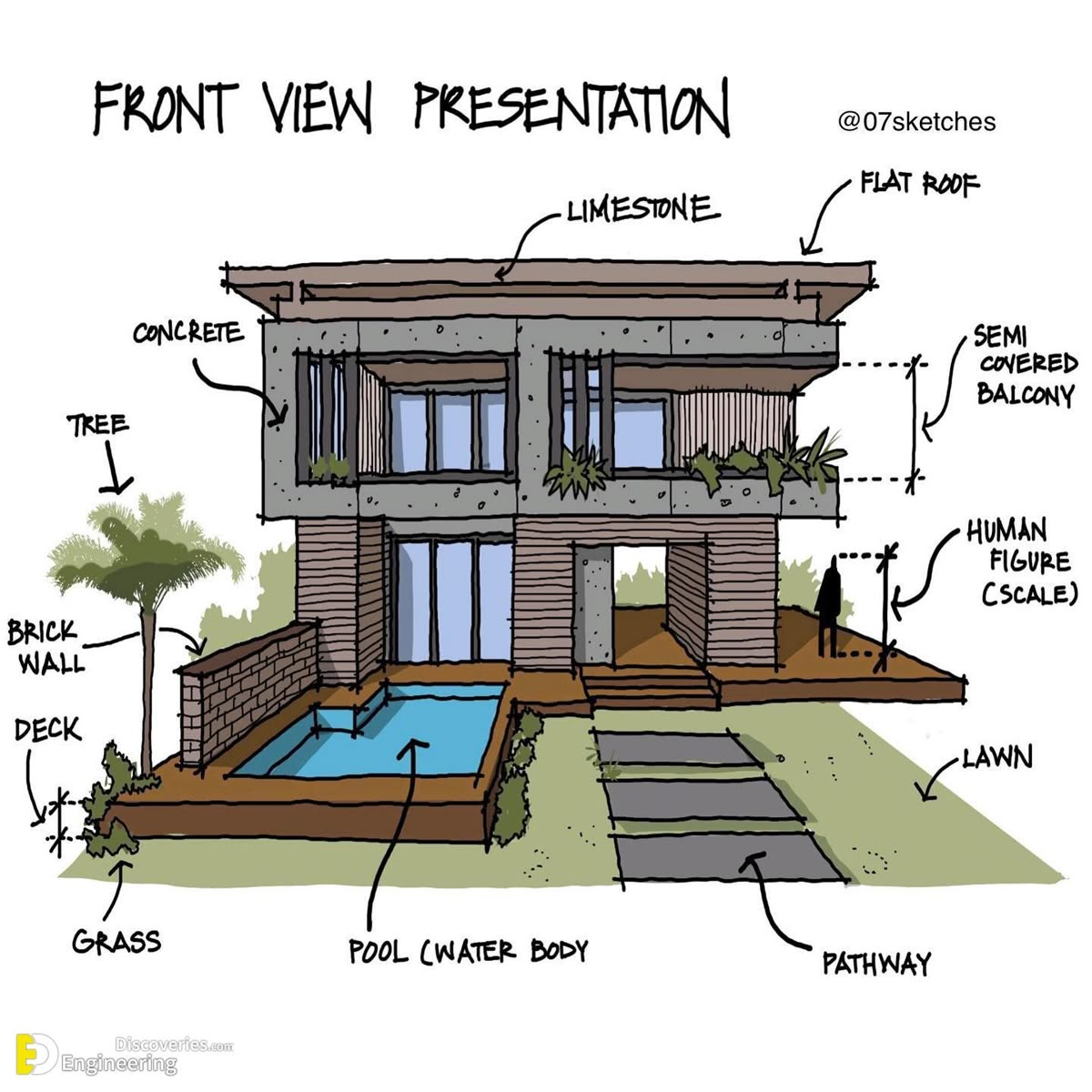In today’s rapidly urbanizing world, the demand for homes that combine functionality, sustainability, and aesthetic beauty has reached an all-time high. Architects and designers are exploring ways to integrate natural materials, eco-friendly features, and modern design principles into their projects. A recent front-view presentation of a contemporary residence showcases exactly that—an architectural masterpiece where minimalism meets nature, and luxury blends seamlessly with sustainability.
This design isn’t just a house; it’s a statement about how the homes of the future can look and feel. Let’s take a deep dive into the details of this presentation and discover why it’s generating so much attention in the world of modern architecture.
1. The Flat Roof: A Modern Symbol
The design begins at the top with a striking flat roof, a defining element of modern homes. Unlike traditional pitched roofs, flat roofs create a clean, geometric silhouette that exudes minimalism. But beyond aesthetics, they also offer practical benefits.
Flat roofs allow the integration of solar panels, rooftop gardens, or even outdoor seating areas. They can serve as green spaces that reduce heat absorption, cutting down on energy use while contributing to sustainability. In urban settings, where space is often limited, the flat roof becomes a multifunctional surface that extends the usability of the home.
2. Natural Materials: Limestone and Concrete
At first glance, the limestone façade draws immediate attention. Limestone is timeless, natural, and elegant. Its earthy tones soften the modern, sharp lines of the building, creating harmony with the surrounding environment.
The use of concrete walls adds contrast and strength. Concrete is durable, resilient, and has become a staple in contemporary design due to its industrial appeal. Together, limestone and concrete represent the perfect balance between warmth and strength, nature and industry.
3. Semi-Covered Balcony: A Bridge Between Indoors and Outdoors
One of the highlights of the presentation is the semi-covered balcony on the upper floor. This feature provides residents with the best of both worlds—shade during hot days and open air during pleasant evenings.
Balconies like these encourage outdoor living, fostering a closer relationship between homeowners and their environment. By being semi-covered, the balcony also ensures that natural ventilation and daylight can filter through without the downsides of direct sunlight or rain.
4. Landscaping: Grass, Trees, and Pathways
No modern home is complete without thoughtful landscaping, and this design excels in that regard. The lawn and grass areas create a sense of openness, while a stepping-stone pathway offers a welcoming approach to the entrance.
A strategically placed tree in the front adds both shade and aesthetic balance, softening the harder concrete and brick elements. This fusion of greenery with strong materials ensures that the house feels less like a concrete block and more like an integrated part of the natural environment.
5. Pool and Wooden Deck: Luxury Meets Relaxation
Adding to the home’s modern appeal is a front-facing swimming pool paired with a wooden deck. This combination elevates the residence into a space of leisure and luxury. Pools serve as both functional amenities and design statements, while wooden decks offer warmth and comfort, creating spaces for family gatherings or quiet reflection.
By placing the pool at the front, the design turns it into a visual highlight, ensuring it’s not hidden away but celebrated as part of the home’s identity.
6. Brick Wall: Tradition Blends with Modernity
The inclusion of a brick boundary wall is subtle yet significant. Brick carries a sense of tradition, grounding the futuristic concrete and limestone design in architectural history. It also adds texture and warmth, ensuring the front façade does not appear too cold or sterile.
7. Human Scale in Design
Another essential feature in the presentation is the human figure included in the drawing. While it may seem minor, this simple addition is critical for architectural communication. By showing a person next to the structure, viewers can immediately understand the scale and proportions of the building. It helps translate abstract lines and shapes into a relatable, real-world experience.
8. Balancing Functionality with Aesthetics
The genius of this front-view presentation lies in its ability to balance functionality and beauty. Every element—whether it’s the pool, the balcony, or the lawn—serves both a practical and aesthetic purpose.
For example:
The flat roof reduces maintenance costs while offering extra usable space.
The semi-covered balcony doubles as an outdoor living area and a climate-control feature.
The pool enhances property value while providing recreation and natural cooling.
This balance ensures the house is not just visually appealing but also livable, sustainable, and future-ready.
9. Sustainability at the Core
Modern architecture is no longer about luxury alone; sustainability is now a non-negotiable aspect of design. This home demonstrates sustainable thinking in several ways:
Use of natural materials like limestone reduces environmental impact.
Flat roof potential for solar panels and gardens reduces reliance on non-renewable energy.
Landscaping and tree integration help regulate microclimates and reduce heat islands.
In essence, the design aligns with global calls for eco-friendly building practices.
10. A Vision for Future Homes
This presentation represents more than just a single home—it’s a vision for the future of residential design. In an era where cities are expanding, and climate challenges are intensifying, homes must adapt. They must be resilient, sustainable, and connected to nature.
The design shows that it’s possible to combine modern aesthetics with eco-conscious principles without compromising on comfort or luxury. It sets an example for architects, developers, and homeowners worldwide.
Conclusion: Architecture That Inspires
The front-view presentation is more than just a drawing—it’s an invitation to imagine how homes can evolve in harmony with the environment. By combining flat roofs, limestone, concrete, thoughtful landscaping, and human-centered features, this design sets a benchmark in contemporary architecture.
It’s not simply about building houses; it’s about creating living experiences that are sustainable, beautiful, and future-ready. And in that sense, this home design stands as a beacon of modern architecture’s potential.
